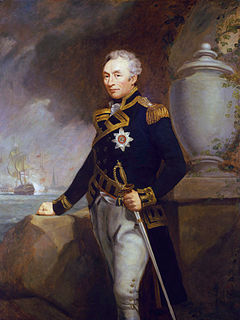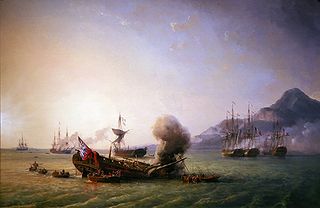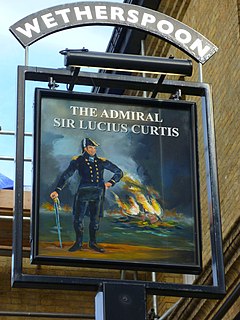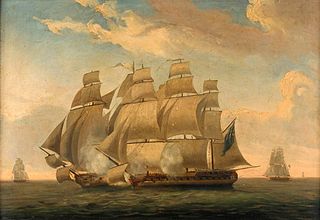This page is based on this
Wikipedia article Text is available under the
CC BY-SA 4.0 license; additional terms may apply.
Images, videos and audio are available under their respective licenses.

Sir Thomas Graves KB was an officer of the Royal Navy who rose to the rank of admiral after service in the Seven Years' War, the American War of Independence, and the French Revolutionary and Napoleonic Wars.

HMS Sirius was a 36-gun fifth-rate frigate of the Royal Navy. Between 1797 and 1805, the Sirius was engaged in maintaining the blockade of Napoleonic Europe. She was lost in 1810 when her crew scuttled her after she grounded during the Battle of Grand Port.

The Battle of Grand Port was a naval battle between squadrons of frigates from the French Navy and the British Royal Navy. The battle was fought during 20–27 August 1810 over possession of the harbour of Grand Port on Isle de France during the Napoleonic Wars. The British squadron of four frigates sought to blockade the port to prevent its use by the French through the capture of the fortified Île de la Passe at its entrance. This position was seized by a British landing party on 13 August, and when a French squadron under Captain Guy-Victor Duperré approached the bay nine days later the British commander, Captain Samuel Pym, decided to lure them into coastal waters where his superior numbers could be brought to bear against the French ships.

Sir Samuel Pym KCB (1778–1855) was a British admiral, brother of Sir William Pym.
Twelve ships of the Royal Navy have borne the name HMS Mosquito, or the archaic HMS Musquito, after the tropical insect, the Mosquito:

HMS Iphigenia was a Royal Navy 36-gun Perseverance-class fifth-rate frigate. She was built at Chatham Dockyard by Master Shipwright Robert Seppings.
Five ships of the Royal Navy have been named HMS Magicienne. The origins of the name are from the French word for a female magician or sorceress and were used following the capture of the French frigate Magicienne in 1781.

Admiral of the Fleet Sir Lucius Curtis, 2nd Baronet, KCB, DL was a senior officer of the Royal Navy during the nineteenth century. The son of Sir Roger Curtis, 1st Baronet, Lord Howe's flag captain at the Glorious First of June, Lucius served during the Napoleonic Wars and was heavily involved in the Mauritius campaign of 1810. During this campaign, Curtis commanded the frigate HMS Magicienne with the blockade squadron under Josias Rowley and was still in command when the ship was destroyed at the Battle of Grand Port. Magicienne grounded on a coral reef early in the engagement and despite the best efforts of Curtis and his crew, the ship had to be abandoned, Curtis setting her on fire to prevent her subsequent capture.
The Dutch brig Komeet was launched in 1789 at Amsterdam. HMS Unicorn captured her on the Irish station in 1795. The British Royal Navy took her into service as HMS Comeet; it renamed her HMS Penguin in 1798. It sold her in 1808.
Poisson Volant, was a popular name for French vessels, including naval vessels and privateers. Between 1760 and 1814, warships of the Royal Navy captured numerous privateers all with the name Poisson Volant.

HMS Magicienne was a 16-gun, steam-powered paddle frigate of the Royal Navy built at Pembroke Dockyard and launched on 7 March 1849.
Théobald-René, Comte de Kergariou-Locmaria was a French Navy officer and Royalist émigré.
The Action of 2 September 1781 was a minor naval engagement fought off Cape Ann during the American War of Independence; HMS Chatham captured the French frigate Magicienne after a fight of a few hours.
Three ships of the French Navy have borne the name Artémise in honour of the goddess Artemis:

The Action of 2 January 1783 was a minor naval battle that took place in the Caribbean during the last stages of the American War of Independence. Severe fighting between a Royal Navy frigate HMS Magicienne and a French frigate Sibylle went on for nearly two hours but in that time both frigates were reduced to a wreck.

HMS Musquito was a 16-gun ship-sloop, previously the French privateer Magicienne or Petite Magicienne. The Royal Navy captured her in March 1798. In modern-day English sources, the ship is oftenly mistaken by a schooner of the same name paid off in 1796. After being captured by the Spanish in September 1798, she served in the Spanish Navy and was eventually broken up in 1805.











